How Do You Price Software As A Service
With the growing adoption of subscription or SaaS pricing models, figuring out how to cost and beak for software has become an intricate process requiring data and insight into your customers' mindsets. Traditional pricing models such as cost-based pricing (i.e. figuring out your costs and adding a profit margin) have fallen past the wayside. Many SaaS companies are implementing subscription services that focus on adding value and increasing recurring revenues through a mixture of different billing models.
Deciding on the right subscription pricing strategy takes time. You need to brand sure products and services are profitable and set up recurring billing up to make information technology easier to predict revenue, handle revenue recognition , and scale with your customers equally they grow. In this blog, we will explore the pros and cons of each pricing model and discuss some examples of each of them in action.
Looking to explore a specific pricing model? Skip ahead to your preferred model past clicking on it in the list below:
- Usage-based or pay as you lot get
- Per-user
- Tiered
- Flat-charge per unit
- Characteristic-based
- Bundling or roll your ain
- Freemium or advertizing-supported
- Hybrid
Usage-based or pay every bit y'all go pricing model
A pricing strategy based on how much customers use the service. It tin can apply one or several different metrics. For instance, phone companies often use this billing model and break it down into different subsets, e.g. the number of texts sent, information used, minutes used. Pricing can also be changed based on fourth dimension of use so that peak hours of usage may take a different charge per unit.
Many companies implement usage-based pricing to appeal to a wide range of customers with different needs. It's important to annotation that it can be a circuitous system, and yous need to call up about how to implement the pay equally you go strategy in a fashion that transparently shows customers the value of your service. Some companies will accuse a recurring monthly fee with add-on charges for extra usage outside of the proposed plan. Others may only have customers pay for what they use.
Usage-based or pay as you become is ofttimes a cheaper and more flexible option from the customer's perspective, and y'all may find that the people most interested in this option see it as a means to save money and stick to their budget more consistently.
Digital Sea , a hosting company that simplifies cloud computing for developers and their teams, has perfected the transparency of usage-based billing, allowing potential customers to hands meet what their usage volition cost for any of the services on offering. Not only do they clearly brandish the monthly rate, simply they clearly bear witness memory, CPU and deejay usage, likewise every bit the hourly spend.
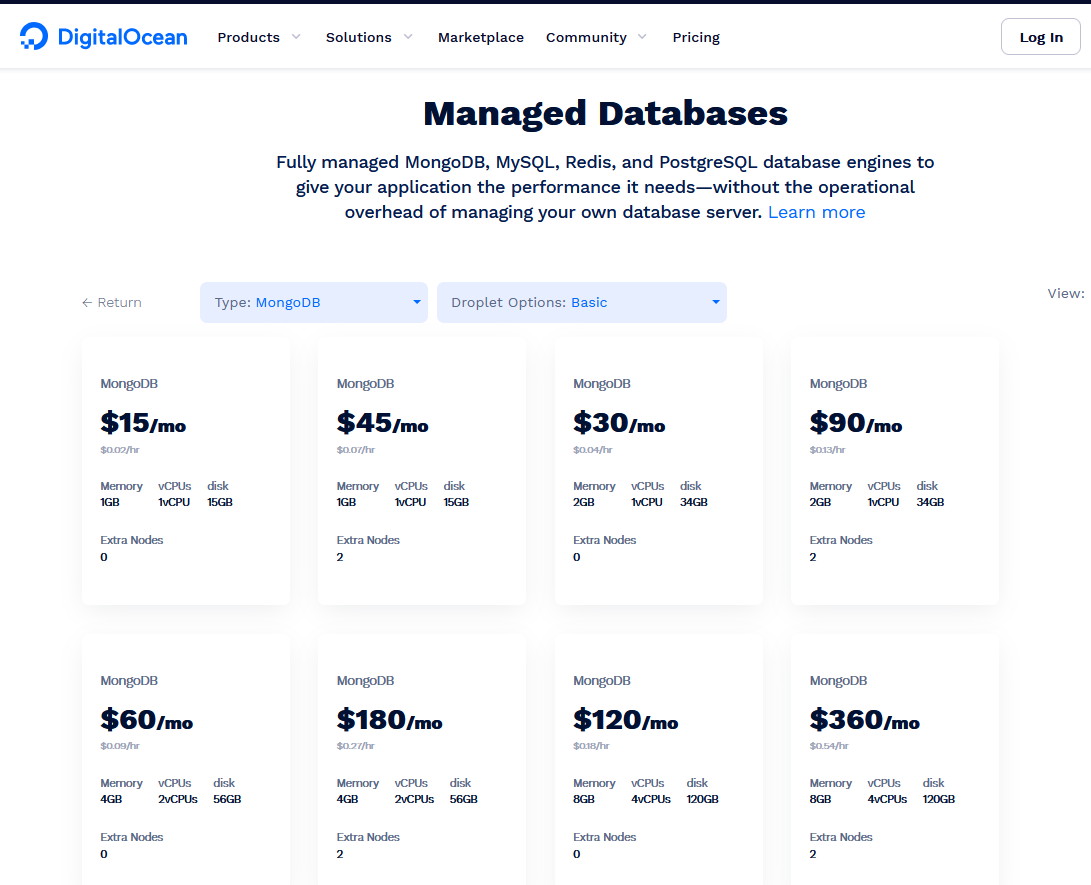
A breakup of the pros and cons of usage-based subscription pricing models
Pros
- Customers don't need to pay a lot of coin if they are using only several features.
- Flexibility allows users to try out your service and increase payments as they build information technology into their lifestyle.
- Heavy users are charged appropriately for the services they're utilizing.
- Less friction at sign-up as it'due south easy for potential subscribers to understand pricing.
- Possible to requite access to more customers by introducing lower tiers with unlike usage rates.
- Recurring billing and revenue recognition are both straightforward and piece of cake to manage.
- Conveying the value of discounts and special offers is unremarkably simple.
Cons
- It tin can be complicated to set upward and difficult for customers to calculate their costs accurately.
- More usage may not correlate to more perceived value from the customer's perspective.
- Your expenses and revenue may fluctuate more dramatically from calendar month to calendar month.
- Has been shown to lower overall consumption as customers change their habits to avail of off-peak pricing.
- May elongate the sales bicycle if customers are unsure of their usage requirements.
- Customers may non necessarily empathise hikes in their billing equally they scale.
Our consummate guide to usage-based pricing gives you several more examples in activity as well as a more comprehensive breakdown of the pros and cons. You can download it equally a booklet hither .
Per-user or per-seat pricing model
Per-user billing is elementary to understand and implement for both the client and the SaaS company. It also reduces the complications that come up when companies onboard multiple team members.
The per-user pricing model allows the customer to pay for each user that uses the software. One thing to be aware of is that people ofttimes effort to cheat the organization, using one login for multiple users. If the fees are exorbitant, it's common to notice companies trying to lower the number of accounts they need.
Microsoft is an example of user-based pricing that is familiar to most. They have successfully implemented this billing model for their Microsoft 365 solutions. Their pricing page is a good instance of knowing how to explain the service offered as well as highlighting and making clear what products customers volition exist able to access.
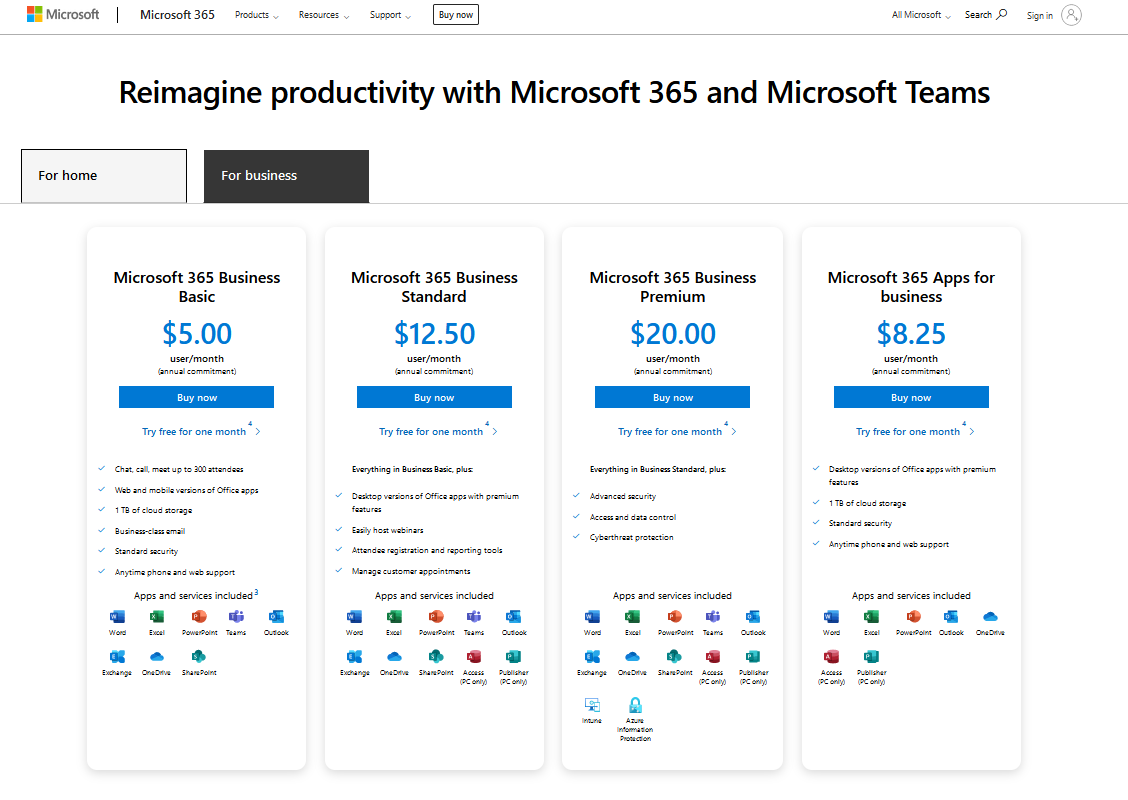
A breakdown of the pros and cons of per-user SaaS pricing models
Pros
- Both yous and your customer tin implement the system hassle-free.
- Gear up easy and tangible growth targets as your revenue scales in line with adoption.
- Forecast revenue with accuracy and ease.
- Users have equal admission to the features of the production.
- Streamlines budgeting and greenbacks flow as calculations are relatively uncomplicated.
Cons
- Limits adoption as customers only add seats they need.
- Incentivises companies to cheat the organisation with multiple users logging in to the same business relationship.
- Susceptible to a high churn rate as only a few people use the tool.
- Customers can be surprised by the increase in price when adding new users during loftier growth periods.
Our complete guide to per-user pricing gives y'all several more examples in action every bit well as a more comprehensive breakup of the pros and cons. You can download it equally a booklet he re .

Tiered pricing model
Tiered pricing is the most common billing model used by SaaS companies. It allows for a lot of flexibility in the software's offering while giving customers the opportunity to level up every bit they offset to run into the benefits of the features. The tiered SaaS pricing model combines well with other strategies. Companies volition ofttimes base of operations the tiers on features, usage or users.
On average, at that place should exist between iii to four tiers to preclude confusion, but anything up to five is reasonable. The merely upshot with as well many options is that it can exist hard for customers to know which 1 they need. They may be overwhelmed and go elsewhere.
The most significant reward of tiered pricing for SaaS companies is the ability to upsell and build their recurring revenue. Tiered pricing must be strategic, with obvious benefits and advantages fabricated available at each tier, so that customers know what value they are currently getting and what other features or usage they can do good from if they unlock features equally they scale.
Hubspot is an example of feature-based tiered pricing laid out intelligently. As yous can run across from the landing page below, they've advisedly mapped out the benefits. One interesting matter to note is that they don't just list features at each level, each tier has a distinctly different listing of business advantages.
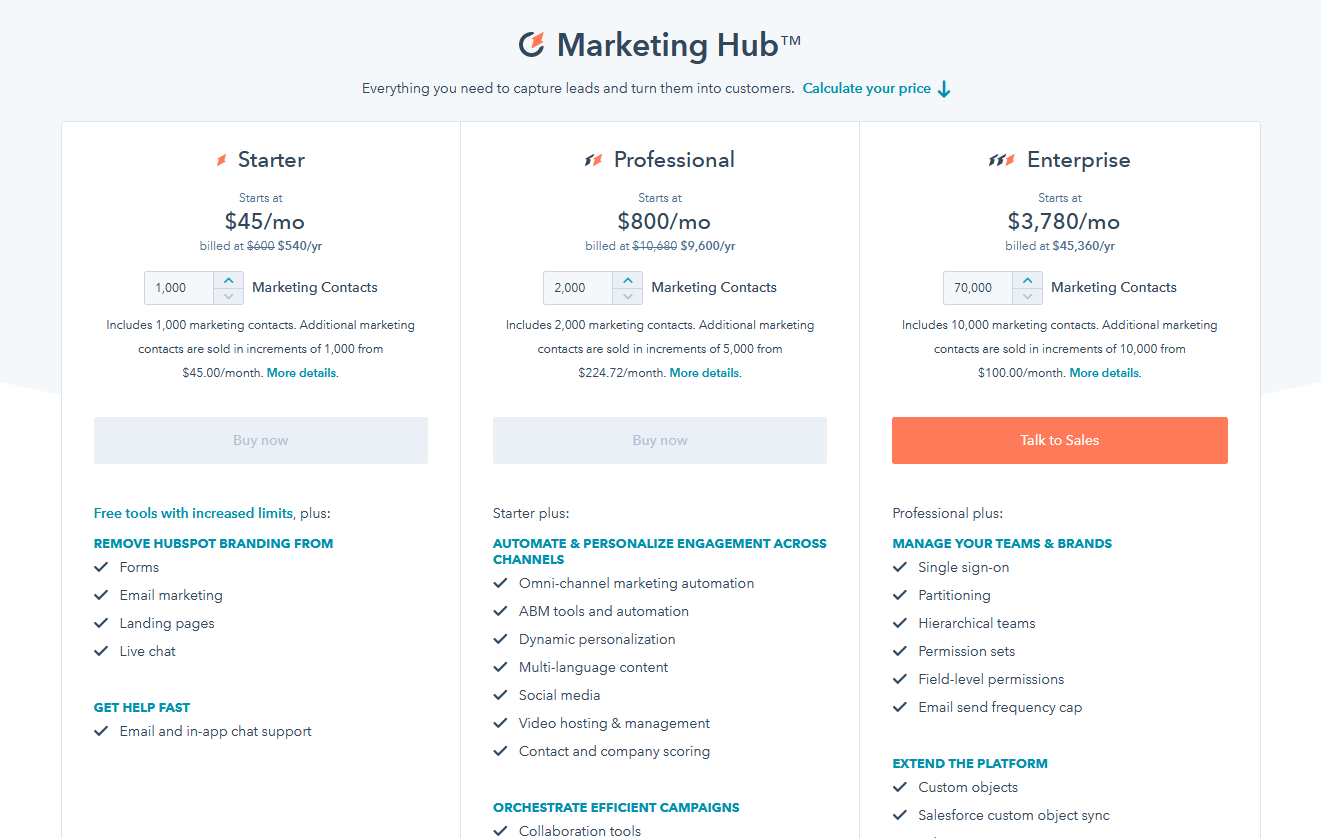
A breakup of the pros and cons of tiered subscription pricing models
Pros
- Attract a wide range of personas and scale with companies as they grow.
- Easier to increase revenue through upselling customers once they've trialled more basic tiers.
- Tailor your tiers to see the needs of a variety of businesses from small mom-and-pop shops to more prominent corporations.
- Gives customers more pick and flexibility.
- Boosts overall conversion rates as your pricing folio can appeal to a wider range of audiences.
- Marketing can focus efforts on specific target audiences for each tier.
Cons
- Confusion over too many tiers can get out customers feeling overwhelmed and unsure about your product.
- Acme-tier users may take advantage of the system with heavy usage.
- Tin can attract the wrong customers past being an "everyman" solution and offering options that are not necessarily profitable for your company to maintain in an attempt to widen the entreatment of the product. Sometimes catering to a specific, niche audition tin reap meliorate results.
- Users may select the wrong tier resulting in a high churn rate.
- Requires a deeper agreement of potential audiences and toll points to execute effectively.
Our consummate guide to tiered pricing gives y'all several more examples in action every bit well as a more comprehensive breakdown of the pros and cons. Yous tin download it as a booklet here .
Flat-rate pricing model
A 1-size-fits-all strategy that cuts downward the possibility of confusion for your customers. Companies accuse all customers the aforementioned amount regardless of usage, users or features needed.
A flat-rate pricing strategy means that companies can brand their value offering very clear, and there's no defoliation over which features will be bachelor to customers. Sometimes, more complicated pricing and tiers can atomic number 82 companies to misunderstand what they're paying for at the lower price points.
Flat-charge per unit pricing is all-time used by companies who have a clear picture show of who their ideal persona is every bit their landing page is probable to appeal to a specific audition. Basecamp is an example of a tool that uses this particular billing type effectively.
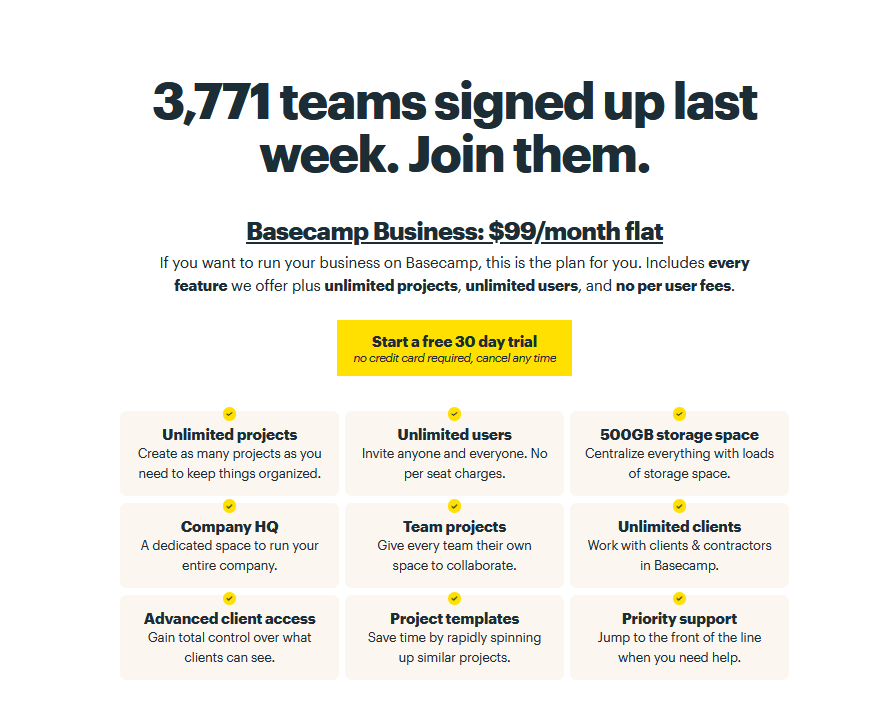
A breakdown of the pros and cons of flat-rate SaaS pricing models
Pros
- It'southward uncomplicated to use and easy to understand.
- Acquirement projections are more than accurate every bit there are fewer complications.
- Easier to create landing pages and marketing collateral as you're only conveying the value of 1 toll point.
- Cuts down the decision-making time and can increase conversions for new customers as there's less to consider.
- Simplifies revenue recognition for recurring billing.
Cons
- 1-size-fits-all may exist immediately off-putting to customers who want custom options.
- Lack of choice tin cause some customers not to have your offer seriously, equally information technology feels as if customers are all treated with a blanket approach.
- Companies want to know you care, and sometimes flat-rate pricing has the negative (and unintended) side effect of making them feel you won't go the extra mile.
- No opportunities to upsell. If companies scale and use your production more, you lot don't make any additional revenue.
- Scaling volition exist problematic equally your flat rate price will only appeal to a specific market/persona.
Our complete guide to flat-rate pricing gives you several more than examples in action as well as a more than comprehensive breakdown of the pros and cons. Y'all tin download it as a booklet hither .
Feature-based pricing model
For software that comes jam-packed with impressive features, it may be best to build tiers based on those features. Users pay more than when they extend the functionality. The highest tier ordinarily offers considerably more functionality than the lower ones. This is ordinarily referred to as feature-based pricing .
One reason this tin can work well is that users get used to using your product, edifice trust and a client human relationship. Frequently growth will mean that companies will face new challenges that your solution can manage. Companies strategically make sure each new tier is a natural progression.
Canva uses characteristic-based pricing, and below you lot tin see how they've laid it out to make it quite clear what problems each tier solves.
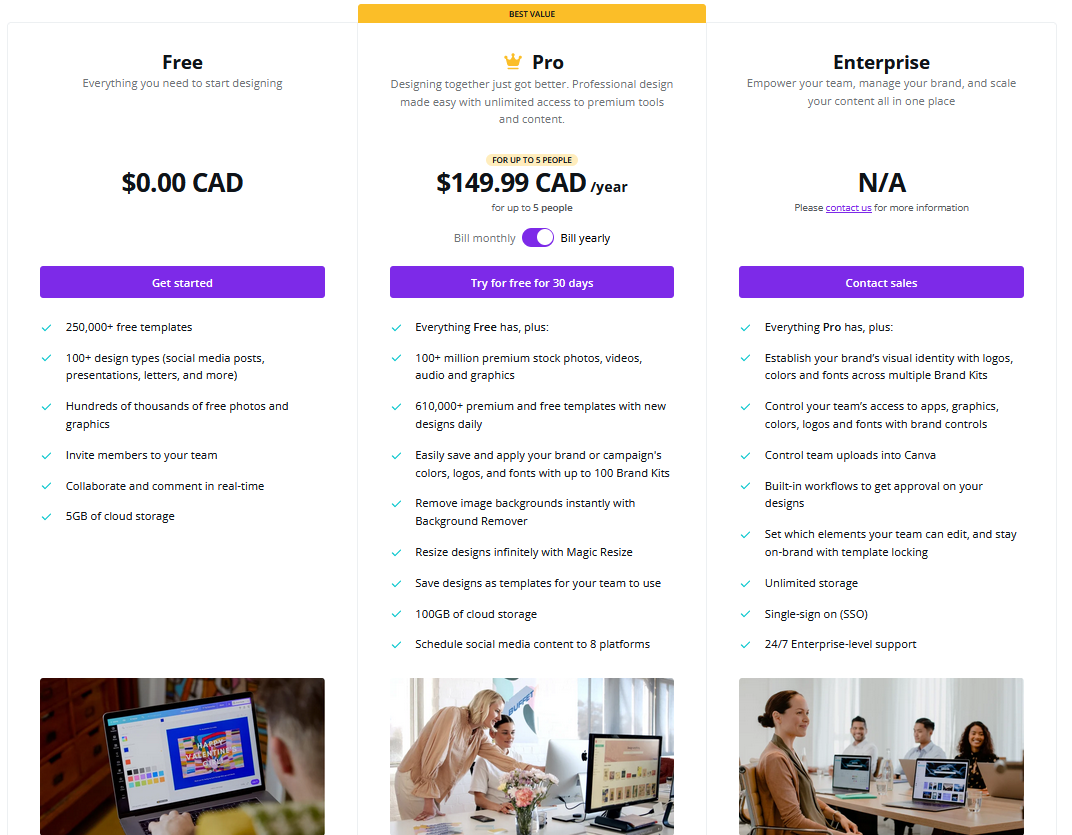
A breakdown of the pros and cons of feature-based SaaS pricing models
Pros
- Upselling is more than natural as the incentive to upgrade to the next tier is clear.
- Allows you to charge appropriately for complex functions that are only needed past select customers.
- Customers can trial your lower tiers to see if they like your software, without having to invest large amounts of money when even so unsure.
- Customers tin easily understand pricing.
- Platonic for hybrid pricing strategies such as a combo of tiered and featured models.
Cons
- Too many features or tiers can atomic number 82 to defoliation.
- It's challenging to carve up features into the appropriate tiers.
- Some basic features demand to be in lower tiers, while still putting enough important features in higher levels to incentivize upgrades. It tin be a tricky balancing act!
- Resentment can build if the customer feels locked out of too many features despite their monthly fee.
- Redundant features are sometimes built to offer more than functionality at every level. Make sure each feature solves a distinct effect and is not just congenital to audio adept on a landing page.
Our complete guide to characteristic-based pricing gives you lot several more examples in action as well as a more comprehensive breakdown of the pros and cons. You can download it every bit a booklet here .
Roll your own/bundling pricing model
Sometimes feature-based or usage-based pricing tin can neglect the expenses incurred on the man-facing side of your enterprise. Information technology may not be easy to interruption your production's features down into tiers or usage-based categories. Maybe it's the case that some functionality will be necessary to one set of users, but not another, and there's no simple way to cater to a more nuanced audition. Peradventure you lot as well notice that you spend a lot of money on training new users, and consulting with them on business issues.
Ofttimes a selection of bundles is the best way to cater to the many needs of a SaaS company, assuasive them to entreatment to more of the market with strategic packages congenital for specific targets. Sometimes, premium customers want the selection to coil their own by creating a bundle with the features and functionality they require, besides as consulting services that volition assistance them make the nigh of the new software.
Many would argue that price bundling should exist a part of any SaaS company's strategy . A breakup of the pros and cons for feature-based pricing there will e'er be users who want tools catered to their industry and past packaging bundles for various markets, you tin increment your sales.
One innovative utilize of a bundling strategy tin be seen on Humble (a game streaming subscription site) that sells time-sensitive bundles, including stats for each one similar how many sold, and when it will expire. This creates a sense of urgency and it's also easy to run into the value of each bundle as they brandish the total cost of the bundled games.
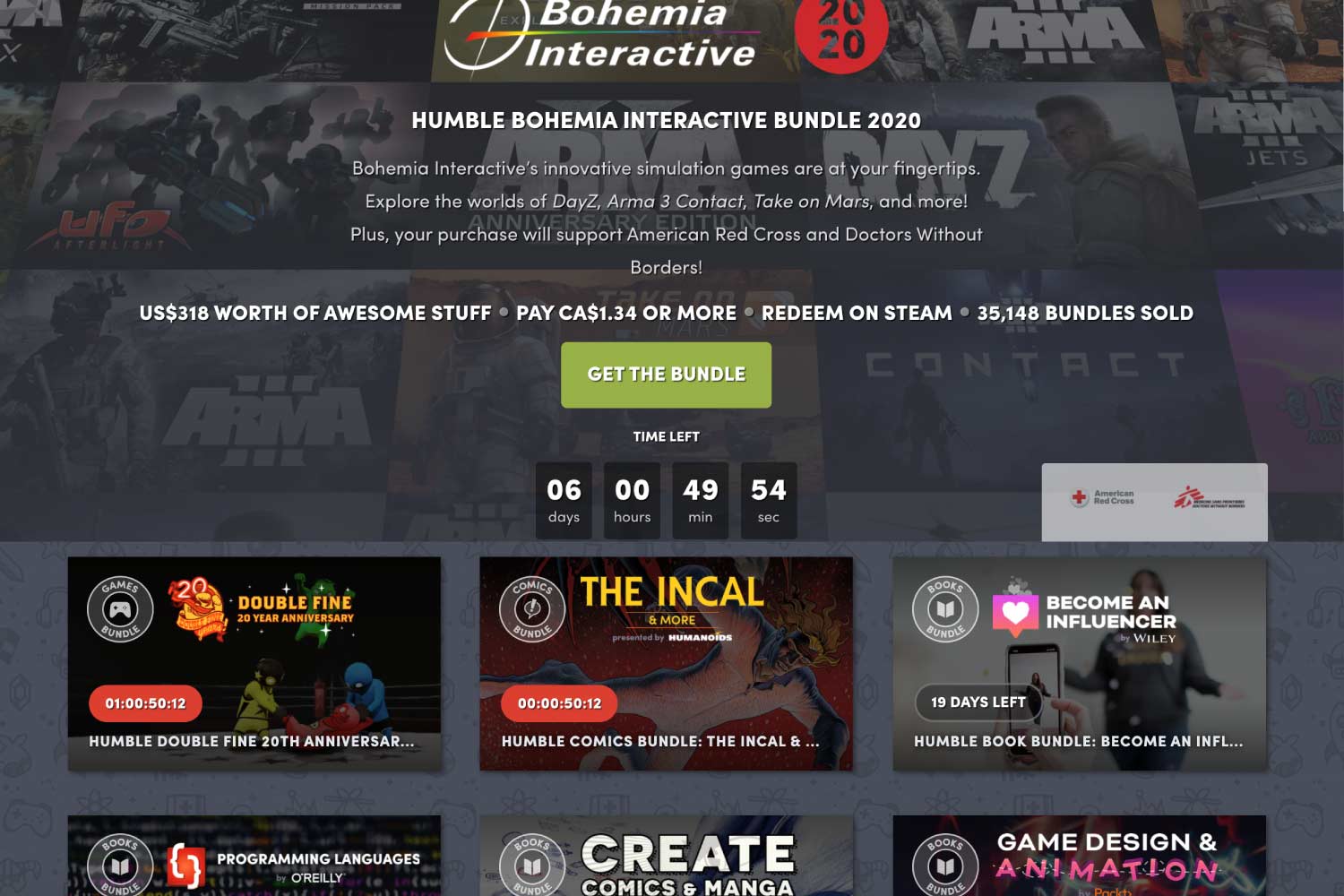
A breakdown of the pros and cons of roll your ain SaaS pricing models
Pros
- Customers experience they get meliorate value with arranged services.
- Speeds upward the sales and implementation process.
- Like shooting fish in a barrel to show overall value past listing bundled services in marketing collateral.
- Adds value without having to add together new functionality or features.
- Increases acquirement from each customer.
- Opportunity to build partnerships in order to enhance bundles with new features.
Cons
- Cost of direction and accounting overhead may increase every bit the bookkeeping team has to create different line items for bundles or have a more robust system that tin can manage bundles.
- Bundling can innovate complications for revenue recognition . It may also make it harder to perform margin analysis on different acquirement streams.
- Confusing if there are too many bundles and limiting if there are as well few.
- Customers may be unable to choice the verbal option they want or feel a bundle includes features they don't desire.
Partnerships with other brands to add together features to your bundles may be distracting and cause you to lose sight of your value offer.
Our complete guide to arranged pricing gives you several more examples in action as well every bit a more comprehensive breakdown of the pros and cons. You can download it equally a booklet here .
Freemium/ad-supported pricing model
The freemium pricing model is widely used by SaaS companies that want to requite people a sense of taste of a limited version of their product. This strategy allows them to concenter new users and gives those customers the opportunity to upgrade to the paid version. Free-versions are often ad-supported.
Dropbox uses its free trial to lure in customers. Users can avail of premium features and see if they're happy with the performance. This has been a successful strategy for Dropbox with high adoption of their services over time.
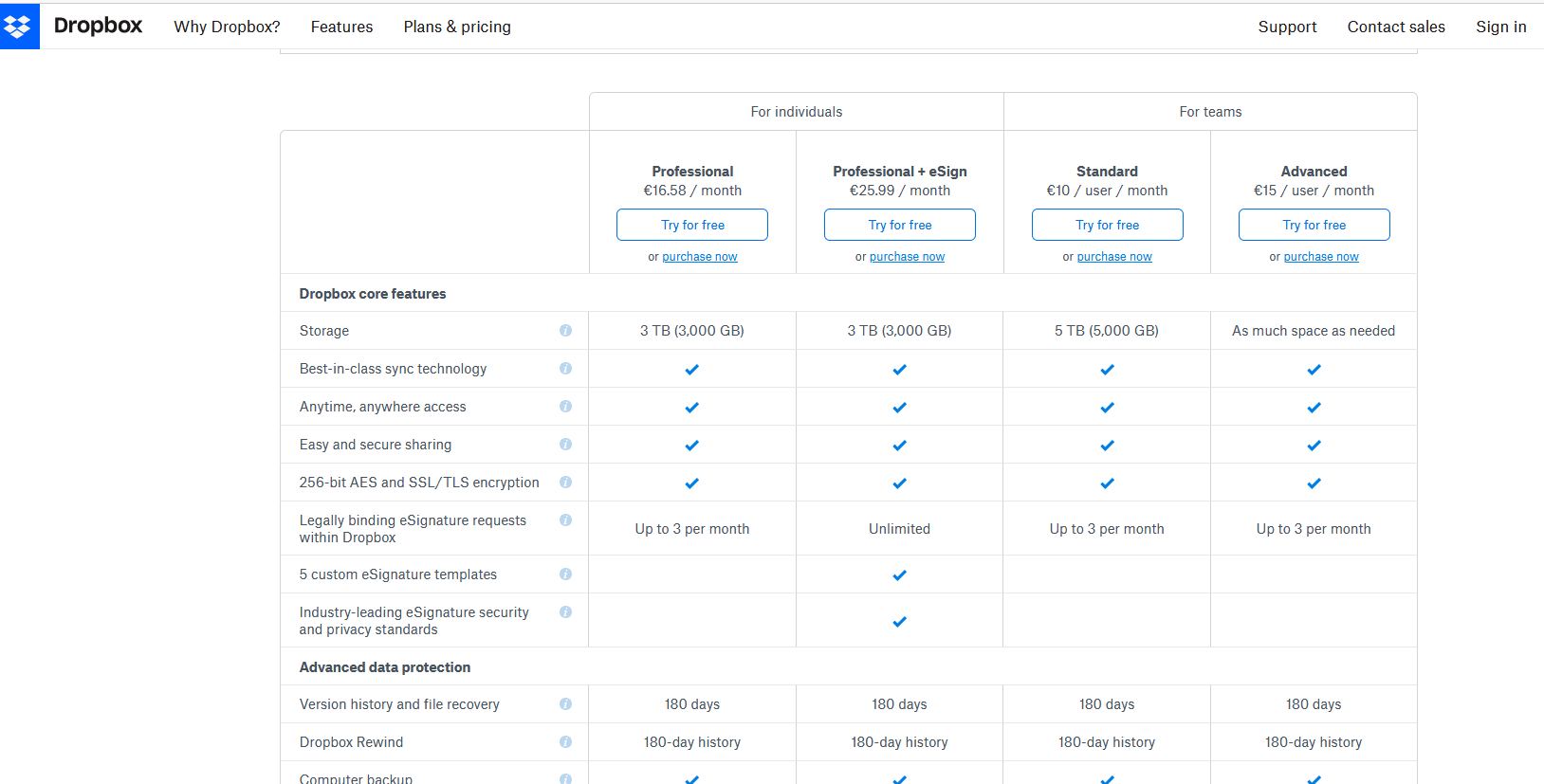
A breakdown of the pros and cons of freemium subscription pricing models
Pros
- Client acquisition costs are lower.
- Free trials tend to lower the bulwark to entry.
- Drives faster product adoption across companies as everyone can try the tools and information technology's non confined to ane or two people on a team.
- Ad-supporting your premium program can help you brand money even when customers are using the service for free.
- Complimentary trials are likely to spread faster by discussion-of-mouth, reducing the amount you need to spend on marketing efforts.
- Free versions can exist an ideal place to experiment with new features.
Cons
- Decrease the perceived value of your product.
- Conversion rates from free to paying customers is frequently lower than it is from lower-priced tiers to premium ones.
- Complimentary users can become an operational burden that requires support without having paid for whatever services.
- Inflated churn rates at the end of gratuitous trial periods.
- An enormous volume of customers is required to recuperate costs.
Our complete guide to freemium pricing gives you several more examples in action as well as a more comprehensive breakdown of the pros and cons. You can download it as a booklet here .
Hybrid pricing model
You lot may have noticed that in that location's a lot of cross-over between the different pricing models, and you lot may be struggling to sympathise the difference between tiered and bundling or usage and per user. That'southward normal. The truth is that most SaaS companies will try a combination of these approaches. Using a hybrid billing model helps companies better toll their subscription services. There's no i-size-fits-all billing model, and it will take fourth dimension, as well every bit thorough customer and market place inquiry, to figure out the best path forward.
Our guide to 5 of the virtually popular hybrid pricing models gives you several more examples in action. You tin can download it as a booklet here .
Implementing the subscription pricing strategy that's right for you
In one case you've considered all the SaaS pricing models, it'south time to decide what works best for your visitor. It will make sense not only to choose the correct strategy but the right tools to assistance implement information technology. Generally, you're going to demand to partner with a company that has experience handling more complicated pricing and billing models.
Subscription Billing Suite allows you to implement all of the SaaS pricing models. So, whether y'all want to bill your customers monthly, quarterly, annually , information technology may just exist the solution for you. Why not find out more below.

How Do You Price Software As A Service,
Source: https://binarystream.com/blog/saas-pricing-models/
Posted by: skipperfringuaing.blogspot.com


0 Response to "How Do You Price Software As A Service"
Post a Comment